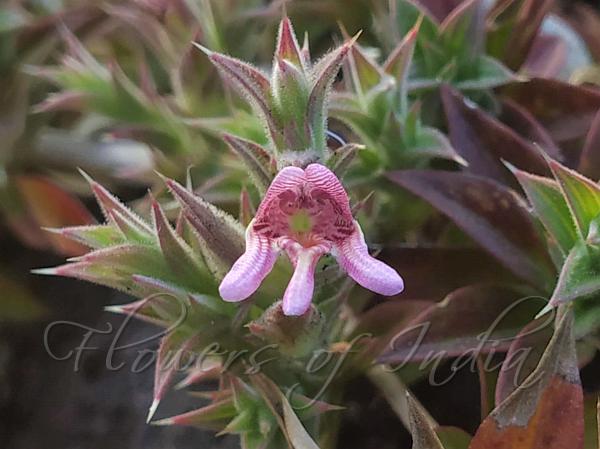|
| Striped Lepidagathis |
|

|

| File size | 518260 |
| Original date | 3/9/21 5:57 PM |
| Resolution | 4000 x 3000 |
| Flash | Flash did not fire, auto |
| Focal length | 3.81mm |
| Exposure time | 1/102s |
| Aperture | 2.2 |
| Focus Distance | |
| Metering Mode | Center weighted average |
| Camera make | Xiaomi |
| Camera model | Redmi Note 5 Pro |
| Sensor type | OneChipColorArea |
|
|
|
|
Photo: |
Botanical name: Lepidagathis ushae Family: Acanthaceae (Acanthus family)
Striped Lepidagathis is a newly discovered (2020)
perennial prostrate, rigid herb, named for Dr Usha Shrirang Yadav, for
her valuable contributions to the cytology and taxonomy of the plants
of the Western Ghats. It is somewhat similar to
Kerala Lepidagathis. Stem is
creeping about 2 m long, whitish, cylindrical (greenish and angular in
vegetative state). Leaves are small, stalkless, opposite, about 1.5-2.0
x 0.5-0.7 cm, oblong-lanceshaped, rigid, recurved at tip,
spiny-pointed, entire at margins. Flowers are borne in spikes at
branch-ends, 5-7 cm long, with 7-15 flowers. Flowers are stalked, about
1.5 cm long, pinkish, velvet-hairy outside, deeply 2-lipped; upper lip
about 3 mm long, bluntly rounded, shortly 2-toothed, with horizontal
pink striations throughout, dark transverse lines on the inner side;
lower lip about 3.5 mm long, deeply divided into 3 equal lobes; lobes
about 3 mm long, oblong, rounded or blunt at tip, hairless, pink to
white. Stamens are 4, filaments about 4 mm long. Sepal-cup is
5-partite, glandular hairy, sepals unequal, spiny-pointed. Bracts are
7-9 x 2-3 mm long, oblong-ovate, glandular hairy, sharply spinous
pointed, 5-prominent nerves, margin entire. Bracteoles are 2, 6-8 x
1.5-2.0 mm long. Capsules are pyramidal, compressed, about 6 mm long,
tip at pointed, brownish to golden, hairless. Striped Lepidagathis is
found in Maharashtra. Flowering: February-March.
| Identification credit: Sushant More | Photographed in Rajapur, Maharashtra. |
• Is this flower misidentified? If yes,